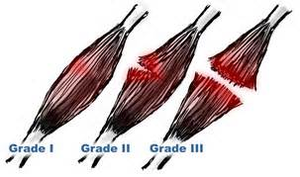Muscle Strain
Original Editor - The Open Physio project.
Top Contributors - Chrysolite Jyothi Kommu, Admin, Yesmine Gouddi, Kim Jackson, Uchechukwu Chukwuemeka, Lucinda hampton, 127.0.0.1, Rachael Lowe and WikiSysop
Introduction[edit | edit source]
A strain to the muscle or muscle tendon is the equivalent of a sprain to ligaments. A muscle strain occurs when muscle fibers cannot cope with the demands placed on them by exercise overload and leads to tearing of the fibers. It is a contraction-induced injury in which muscle fibers tear due to extensive mechanical stress. This mostly occurs as result of a powerful eccentric contraction or overstretching of the muscle. Therefore, it is typical for non contact sports with dynamic character such as sprinting, jumping… .[1].
Categorization[edit | edit source]
Strains are categorized into 3 grades of severity[2][3][4]:
Grade I (mild) strains affect only a limited number of fibers in the muscle. There is no decrease in strength and there is full active and passive range of motion. Pain and tenderness are often delayed to the next day.
Grade II (moderate) strains have nearly half of muscle fibers torn. Acute and significant pain is accompanied by swelling and a minor decrease in muscle strength.
Grade III (severe) strains represent complete rupture of the muscle. This means either the tendon is separated from the muscle belly or the muscle belly is actually torn in 2 parts. Severe swelling and pain and a complete loss of function are characteristic for this type of strain.
Signs and symptoms[edit | edit source]
Symptoms of muscle strain include:[5]
- Swelling, bruising, or redness due to the injury
- Pain at rest
- Inability to use the muscle at all
- Weakness of the muscle or tendons
Risk factors[edit | edit source]
Strains are not restricted to athletes and can happen while doing everyday tasks, Athletes are more at risk for developing a strain. It is common for an injury to occur when there is a sudden increase in duration, intensity, or frequency of an activity.[6]
Management[edit | edit source]
Muscle strain treatment depends upon an accurate diagnosis from your health professional. The severity of your muscle strain, and what function or loads your injured muscle will need to cope with, will impact the length of your healing and rehabilitation process.
The first-line treatment for a muscular strain in the acute phase include five steps commonly known as P.R.I.C.E.[7]
- Protection: Apply soft padding to minimize impact with objects.
- Rest: Rest is necessary to accelerate healing and reduce the potential for re-injury.
- Ice: Apply ice to induce vasoconstriction, which will reduce blood flow to the site of injury. Never ice for more than 20 minutes at a time.
- Compression: Wrap the strained area with a soft-wrapped bandage to reduce further diapedesis and promote lymphatic drainage.
- Elevation: Keep the strained area as close to the level of the heart as is possible in order to promote venous blood return to the systemic circulation.
The first treatment is usually an adjunctive therapy of NSAIDs and Cold compression therapy. Cold compression therapy acts to reduce swelling and pain by reducing leukocyte extravasation into the injured area.[8] NSAIDs such as Ibuprofen/paracetamol work to reduce the immediate inflammation.
A new treatment for acute strains is the use of platelet rich plasma (PRP) injections which have been shown to accelerate recovery from non surgical muscular injuries.[9]
Related Articles[edit | edit source]
Compare to ligament sprain
- Hamstring Strain[1]
- Quadriceps Muscle Strain[2]
- Calf Strain[3]
- Groin Strain Rotator Cuff Tears
- Rotator Cuff TearsRupture Long Head Biceps
- Rupture Long Head BicepsAchilles Rupture
- Achilles Rupture
Recent Related Research (from Pubmed)[edit | edit source]
Failed to load RSS feed from http://eutils.ncbi.nlm.nih.gov/entrez/eutils/erss.cgi?rss_guid=1HoKZG5k4YSBTpqDugsRtDnd9bevOAtrmNBHScVXfE58ejzYL_: Error parsing XML for RSS
References[edit | edit source]
References will automatically be added here, see adding references tutorial.
- ↑ Garrett WE. Muscle strain injuries. Am J Sports Med. 1996; 24:S2-88
- ↑ Tero AH Järvinen, Teppo LN Järvinen, Minna Kääriäinen, Hannu Kalimo, Markku Järvinen. Basic Science Update: Muscle Treatment. Am J Sports;May;33:745-­‐764
- ↑ Järvinen M, Tero AH. Muscle strain injuries. Rheumatology. 2010(2); 12: 155-161
- ↑ Kneeland JP. MR imaging of muscle and tendon injury. Eur J Radiol. Nov 1997; 25(3):198-208
- ↑ Brumitt, Jason; Cuddeford, Tyler (November 2015). "CURRENT CONCEPTS OF MUSCLE AND TENDON ADAPTATION TO STRENGTH AND CONDITIONING". International Journal of Sports Physical Therapy. 10 (6): 748–759. ISSN 2159-2896. PMC 4637912. PMID 26618057.
- ↑ "Sprains, Strains and Other Soft-Tissue Injuries-OrthoInfo - AAOS". orthoinfo.aaos.org. Retrieved 2017-06-25.
- ↑ T. A. Järvinen, et al., "Muscle injuries: optimising recovery" , Best Pract Res Clin Rheumatol., 21 (2) April 2007, pp. 317-31.
- ↑ k.dilshad. "Tissue Response to Injury" (PDF). webcache.googleusercontent.com. Archived from the original (PDF) on 2017-10-31. Retrieved 2017-06-25
- ↑ Halpern, Brian C.; Chaudhury, Salma; Rodeo, Scott A. (2012-07-01). "The role of platelet-rich plasma in inducing musculoskeletal tissue healing". HSS journal: the musculoskeletal journal of Hospital for Special Surgery. 8 (2): 137–145. doi:10.1007/s11420-011-9239-7. ISSN 1556-3316. PMC 3715623. PMID 23874254







